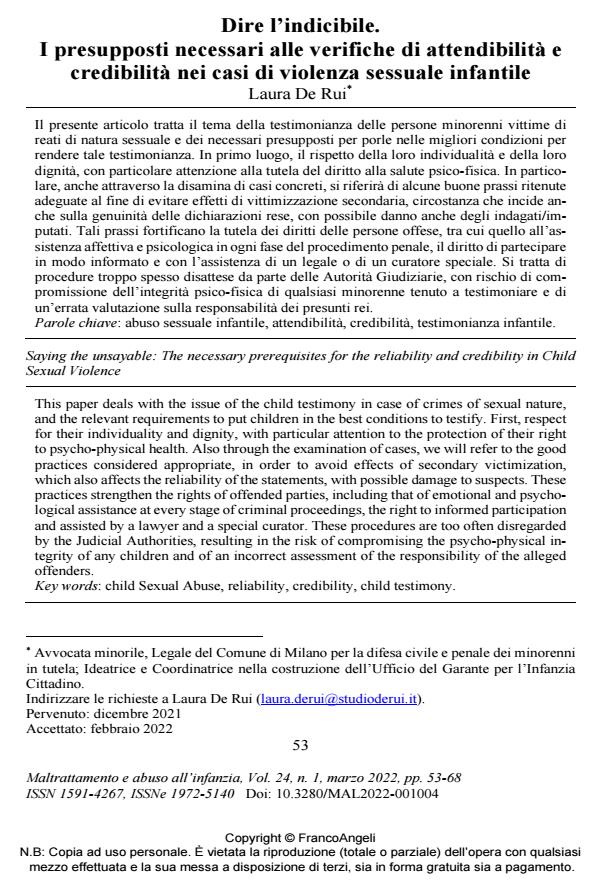Saying the unsayable: The necessary prerequisites for the reliability and credibility in Child Sexual Violence
Journal title MALTRATTAMENTO E ABUSO ALL’INFANZIA
Author/s Laura De Rui
Publishing Year 2022 Issue 2022/1 Language Italian
Pages 16 P. 53-68 File size 184 KB
DOI 10.3280/MAL2022-001004
DOI is like a bar code for intellectual property: to have more infomation
click here
Below, you can see the article first page
If you want to buy this article in PDF format, you can do it, following the instructions to buy download credits

FrancoAngeli is member of Publishers International Linking Association, Inc (PILA), a not-for-profit association which run the CrossRef service enabling links to and from online scholarly content.
This paper deals with the issue of the child testimony in case of crimes of sexual nature, and the relevant requirements to put children in the best conditions to testify. First, respect for their individuality and dignity, with particular attention to the protection of their right to psycho-physical health. Also through the examination of cases, we will refer to the good practices considered appropriate, in order to avoid effects of secondary victimization, which also affects the reliability of the statements, with possible damage to suspects. These prac-tices strengthen the rights of offended parties, including that of emotional and psychological assistance at every stage of criminal proceedings, the right to informed participation and assisted by a lawyer and a special curator. These procedures are too often disregarded by the Judicial Authorities, resulting in the risk of compromising the psycho-physical integrity of any children and of an incorrect assessment of the responsibility of the alleged offenders.
Keywords: child Sexual Abuse, reliability, credibility, child testimony.
- Coffey, P., Leitenberg, H., Henning, K., Turner, T., & Bennett, R. T. (1996). Mediators of the long-term impact of child sexual abuse: Perceived stigma, betrayal, powerlessness, and self-blame. Child Abuse & Neglect, 20(5), 447-455. DOI: 10.1016/0145-2134(96)00019-1
- Di Blasio, P. (2006). I procedimenti penali nei casi di abuso sessuale in danno ai minori. Maltrattamento e abuso all’infanzia, 8(3), 7-8. DOI: 10.1400/70049
- Di Blasio, P., Miragoli, S., & De Rui, L. (2006). I tempi del bambino e i tempi della giustizia: analisi dei procedimenti penali per abuso sessuale a danno di minori. Maltrattamento e abuso all’infanzia, 8(3), 37-56.
- Miragoli S., Camisasca, E., & Di Blasio, P. (2019). Le emozioni dei bambini sessualmente abusati nelle audizioni protette: fattori individuali e situazionali. Ricerche di Psicologia, 42(1), 483-504. DOI: 10.3280/RIP2019-003003
- Miragoli S., & Milani, L. (2019). L’effetto di mediazione delle emozioni traumatiche nella relazione tra PTSD e coerenza narrativa in testimonianze di Child Sexual Abuse. Maltrattamento e abuso all’infanzia, 21(2), 61-77. DOI: 10.3280/MAL2019-002005
- Miragoli, S., Procaccia, R., & Di Blasio, P. (2014). Language use and PTSD symptoms: Content analyses of allegations of child sexual abuse. Journal of Forensic Psychology Practice, 14(5), 355-382. DOI: 10.1080/15228932.2014.970423
- Procaccia, R. (2006). L’ascolto del minore vittima di violenza tra esigenze cliniche e giuridiche. Maltrattamento e abuso all’infanzia, 18(2), 7-12. DOI: 10.3280/MAL2016-002001
- Il ruolo attivo della vittima in caso di abuso sessuale: conseguenze in adolescenza Rachele Maria Valentini, in MALTRATTAMENTO E ABUSO ALL'INFANZIA 3/2023 pp.107
DOI: 10.3280/MAL2022-003006
Laura De Rui, Dire l’indicibile. I presupposti necessari alle verifiche di attendibilità e credibilità nei casi di violenza sessuale infantile in "MALTRATTAMENTO E ABUSO ALL’INFANZIA" 1/2022, pp 53-68, DOI: 10.3280/MAL2022-001004